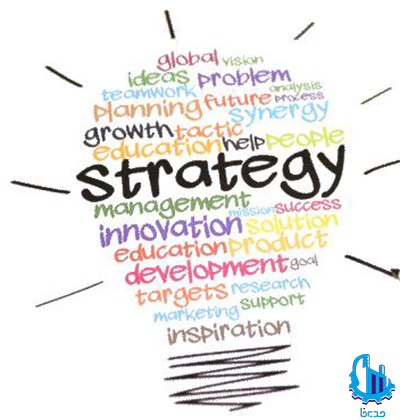Part I:
Definition of strategies by Fred R. David
The first category of strategies:
Integrated strategy
The first type:
Integrated backward vertical strategy
(downward or backward)
In this type of strategy, the organization tries to increase its dominance over its suppliers with a series of activities such as buying all or some of the shares or restarting a business. This means that what it buys for its own production or services as raw materials, necessities or services that enter the organization initially, is produced by the organization itself or buys the shares of those companies to the degree of mastery. Increase yourself on them. The most important reason for this is that perhaps the suppliers cannot implement things such as the desired quality, cost or delivery time that the organization intends.
In general, Michael Porter and Fred R. David’s point of view in the field of strategy is the topic of competitive advantage and bargaining power. In general, integrated strategies (upward vertical integration and downward vertical integration) work on the organization’s bargaining power. The organization works backward vertical integration when the bargaining power of suppliers increases and wants to lower it, and it works on upward integration when the bargaining power of its customers increases and wants this bargaining power. In general, it can be said that one of the most important parameters in organizations that affects their improvement, their quality, and their progress is the issue of inputs, whether they are raw materials, necessities, or services.
In this category of strategies, organizations try to dominate the producers and suppliers of such raw materials and requirements and services.
An example of a vertically integrated backward strategy
For example, consider an ice cream manufacturer who has been importing ice cream sticks from Turkey until now, and now he is producing them himself, so that he can increase the production rate, buy a machine for ice cream sticks, and produce the ice cream sticks himself so that he can control the amount of the stick. Ice cream, which is very important to increase the quality of its product. Among the other reasons we can have for using a vertical downward integrated strategy is that the amount of production of suppliers and the amount of demand in the country are far from each other, i.e. the demand It should be more to increase the amount of production and create the opportunity for the organization to invest. By the way, it was around 1993 or 1994 that I was a consultant for an organization that wanted to produce coated tin sheets, the consumption of coated tin sheets in Iran was much higher than its production, and this company created a trading company in which the sheet trading company He imports the coated tin and uses it himself. The very interesting thing about backward integrated strategies is that when you make this investment and implement this strategy for yourself, you no longer need to import tin-plated sheets for yourself, but you can import them to other manufacturers. sell that this will greatly increase your dominance on the market and your recognition on the market and your impact on consumers and customers and it can be profitable for you, but there will definitely be some weaknesses in this strategy that We will address it.
Now that you are familiar with the backward integrated strategy, you will probably come to the conclusion that it is a very widely used strategy and it is good for organizations to use it, but this strategy cannot be used by all organizations for many major reasons. For whom this strategy is useful, they may not be able to use this strategy. The three main reasons are:
1. Investment: As you know, starting a new business or restarting a supplier or buying its shares, either in whole or in part, requires a capital that maybe not all organizations can afford this investment or reinvestment.
2. Technical knowledge: Technical knowledge has the greatest effect and those who like to use the reverse integration and need this strategy, do not have the technical knowledge of that supplier and cannot use it due to the lack of knowledge and cannot control this risk in this way. stay
3. Econometric studies: This strategy requires econometric studies and a very strong justification plan that organizations may not be able to afford. have and use it.
But in a situation where this strategy can be used, it is one of the very strong strategies that raises the position of the organization in the industry and in the market very well, and this is very beneficial for many holdings, if the investment or holding works. They can work in the chain of one product, they can have both backward integration and forward integration in their own holding, for example, we have this in Golrang and there are other examples in Iran and the world that use these integrated strategies. and increased their influence greatly and made the ocean blue for themselves, they swam from the red ocean to the blue ocean. This strategy is one of the strategies that need many strengths, it has many opportunities, and there must be a weakness in that supplier or those raw materials or those services that you are talking about so that we can use these strengths and Let’s use the opportunities and cover these weaknesses.
Conclusion :
In the first part of Michael Porter’s and Fred R. David’s series of strategies, vertical integration is a strategy in which you try to increase your dominance over suppliers, and this strategy is a winning strategy when you have the required capital, Have the right market, opportunity, human resources and technical knowledge in this field. Keep in mind that integrated strategies are the type of strategies that work on your competitive advantage. Generally, all of Michael Porter and Fred R. David’s strategies are in the field of competitive advantage, but these two strategies will give you a competitive advantage that may be very difficult for others. Organizations can reach it, so if you have the conditions to use these strategies, one of your choices must be vertically integrated strategies forward or backward so that you can bring your name to the top of that market. I have always said that because in an industry To be able to make money, you must be one of the industry, be the industry leader, the second person and the third person do not work. Blue ocean strategy. You must be the first and the leader. You must be strong enough that everyone copies you. You can reach this point.
We saw and heard what vertically integrated forward or backward strategies are and how they benefit organizations. Let’s use your experience in organizations. What do you think about this strategy? Where does this strategy benefit organizations? What are the strengths and weaknesses of this type of strategy? And do you have any experience? Do you know an Iranian or foreign organization that has used this strategy? And have you ever used this strategy in your organization? Or if you haven’t used it yet, have you chosen to use it yet? And what are the reasons why it didn’t happen?




No views